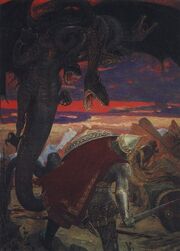The dragon is a common element of the fantasy genre. Dragons can typically be divided into two categories based on the cultures that created them: Eastern Dragons and Western Dragons.
Eastern Dragons[]
Physically, the dragons of Korea, China and Japan have the body of a snake, belly of a frog, scales of a carp, head of a camel, horns of a giant stag, eyes of a hare, ears like a bull, neck like an iguana, paws like a tiger, and claws like an eagle, with a few slight variations between cultures. For example, Chinese dragons have five toes, Korean dragons have four toes, and Japanese dragons have three.
Unlike most types of dragon, most Eastern Dragons have no wings and use magic to fly. These dragons were also the primary source of rain and could cause dangerous floods if they were angered. Most of the Eastern dragons could shape-shift, taking the form of different creatures such as beasts or man. Whenever they did this, they were always the most beautiful and kind of all the species. In turn, other animals, including humans, could become dragons.
Fish could take the challenge to become a dragon at the Dragon's gate. Any that could swim against torrents of water and clear a huge leap would undergo the instantaneous transformation. This gate is located in the Yellow River at the border between the Shensi and Shansi providences. In addition, the dragons are said to rise from this gate in to the skies in the spring and descend into the waters in autumn. (Chinese Mythology by Anthony Christie)

Western Dragons[]
The typical Western dragon is a large, scaly creature resembling a dinosaur or a large lizard. It usually has wings and can fly; often it will breathe fire, lightning, or ice. Frequently, they guard a stash of gold. Western dragons are often used to symbolize greed.
Although many Western dragons are brutal, ignorant creatures who kill and eat humans others are ancient, wise creatures more akin to those found in the East, especially in modern fiction. The concept of an intelligent Western dragon was largely introduced by J.R.R. Tolkien with the character of Smaug.
Less Common Dragon Species[]
- The wyvern is a relative of the dragon often seen in medieval heraldry. It is frequently depicted as having two legs and two wings, occasionally with eagle's claws on the wingtips. The sea-wyvern has a fish-like tail.
- Wyrm can be used to reference any dragon, but applies specifically to serpent-like, water-dwelling dragons.
- Hydras are many-headed dragons, the most well-known example being the Hydra slain by Hercules in Greek mythology
Dragons in Literature[]
- The Bible -- the dragon is one form taken by the devil.
- The Hobbit by J.R.R. Tolkein -- Smaug is an evil dragon that lives on Lonely Mountain.
- So You Want to be a Wizard by Diane Duane -- a greedy, paranoid dragon lives in the subway system of an alternate world Manhattan.
- The Dragonriders of Pern series by Anne McCaffery -- telepathic, genetically engineered dragons protect the planet from deadly spores called Thread
- The Inheritance Trilogy by Christopher Paolini -- Contains "Riders", humans who are connected to a dragon chosen for them by fate. They have the ability to communicate telepathically to one another.
- Harry Potter series by J.K. Rowling -- Hagrid hatches a baby Norwegian Ridgeback in the Sorcerer's Stone, Harry must out-fly a Hungarian Horntail in the Goblet of Fire, and Harry, Ron and Hermione ride the blind guard-dragon kept in the bowels of Gringotts in the Deathly Hallows.
- His Majesty's Dragon by Naiomi Novik-- the dragons are "harnessed," and remain mainly attached to their "captains" in the captain does not die. Also, the language spoken outside the egg is heard by the chick, andit speaks the language when it hatches. If a dragon is not harnessed, it becomes feral, and does not always listen to a later captain.
Common Absurdities[]
- Telepathic dragons being bonded to their riders. It was a great idea, but it's already been done.
- Ignoring the food chain. A dragon is a top predator and as such will need a large territory with ample prey.
- A dragon should not be the fantasy equivalent of an F-35.
Resources[]
- Original Writerium Article[1]